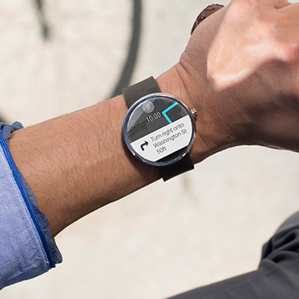A lire sur: http://www.technologyreview.com/news/525791/coming-soon-android-apps-for-wearable-devices/
Developers and designers are now building apps for Google’s smart watch platform.
Developers and designers are now building apps for Google’s smart watch platform.
WHY IT MATTERS
Smart watches could have as much impact as smartphones, if developers get interested.

New direction: A mockup of a turn-by-turn
The designers of the forthcoming Moto 360 hope they’ve passed a fashion test. In contrast to the often bulky and boxy smart watches released to date (see “Smart Watches Need a Makeover, and a Shrink Ray”), their device is sleek and perfectly round, evoking the style of a classic analog wristwatch.
But beneath the slick design lies even slicker software. A new version of Android, called Android Wear (see“New SDK Shows Google Really Wants to Get on Your Body”), allows apps for the watch to be created using simple tweaks to existing Android apps.
The nice design and promised ease of development have encouraged a handful of developers and designers to prototype the first wearable apps for Android Wear. For example, a developer at the startup Pocket has proposed an app that would let someone wearing the watch slip notifications and e-mail alerts into a special folder for later review on his smartphone. Designers, meanwhile, have mocked up wearable apps including trip planners andspeed-reading e-mail clients using the interface guidelines included with Android Wear.
While the market for wrist-worn computing is uncertain, Google hopes to gain an early edge by leveraging the many Android developers already out there. Other smart watches, including the Pebble and the latest Samsung Galaxy Gear, use their own operating systems, forcing prospective developers to learn to code for a new platform.
Samsung put a new operating system, called Tizen, on the latest version of its Galaxy Gear smart watch (see “Samsung Weans Itself from Android, at Least for Smart Watches”) partly to undermine the dominance Google has achieved so far in mobile software. The release of Android Wear is also something of a preëmptive strike, since Apple is widely expected to release its own watch this year.
Android’s dominant position in mobile software could give it an edge over Apple in smart watches. Cecilia Abadie, a developer at 33Labs, a mobile development company in Los Angeles, says she is building a personal fitness training app and personal assistant app for the Moto 360. “Android Wear has better chances of winning the next big battle of wearables against Apple, in the same way Android itself won the battle in number of [smartphone] units sold,” she says.
Det Ansinn, president of BrickSimple, an Android app development firm in Doylestown, Pennsylvania, says he’s already experimenting with the new software development kit. “They’ve made it very easy for Android developers to support experiences on these watches,” he says. “You can generate a notification that generates meaningful controls using the exact same notification mechanisms that you are familiar with.”
The Moto 360 was created by Motorola Mobility, which Google is in the process of selling to Lenovo. The smart watch won’t be out until summer, and no price has been diclosed. And while no third-party apps have yet been released for Android Wear, Google has shown some concepts, including weather and traffic updates, the ability to dictate short e-mails, and turn-by-turn directions.
“Basically apps on the phone already have an on-ramp to the watch,” says Ansinn. “It makes the Android Wear devices truly an extension of the device in the pocket.” He points out that dismissing a notification on a watch also dismisses it on the phone.
The software development kit lets developers integrate Google’s voice-driven personal assistant Google Now into their software for smart watches and other devices. In announcing the software development kit last week, Google said it’s working with companies including Asus, HTC, LG, Samsung, Intel, Qualcomm, and Fossil Group to build devices that can use Android Wear apps.
The Moto 360 will have swipe controls, but Abadie of 33Labs believes good voice control will determine whether consumers actually find it convenient to use the device. “As people get used to talking to their devices, we’ll see that in the next few years, all software and hardware will need to add a new layer of voice, allowing people to talk to them and being able to talk back,” she says. “These devices will make voice mainstream again.”
If smart watches are to gain mainstream acceptance, they’ll also need to be well-designed. In a talk last week, Jim Wicks, lead designer of Moto 360, says the first priority was making sure consumers would actually want to wear the smart watch. Not all early wearable gadgets have passed that bar: Google Glass has been hampered by reactions that it is bizarre, geeky, and downright creepy. Those reactions have, in turn, limited developers’ appetite for writing Glass apps.
To help the Moto 360 “pass the fashion test,” Wicks says, his team chose a brushed stainless steel case, optional leather straps, and the familiar round shape that most people choose when buying a traditional watch. And they banished cameras: “We did not see it as essential,” he says.
But Wicks acknowledges that other features will be equally crucial to the device’s popularity: for example, easy tie-in with Android apps, and the “ability to talk to your watch, and have it do things for you.”
Aucun commentaire:
Enregistrer un commentaire